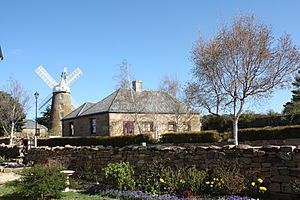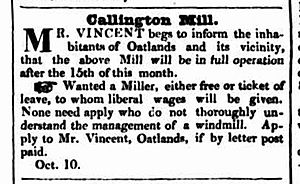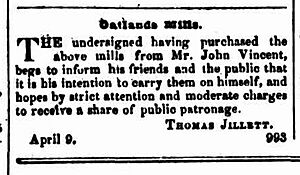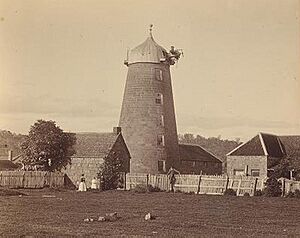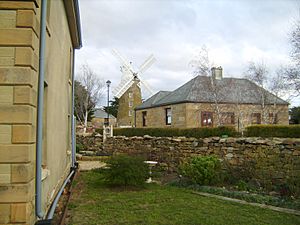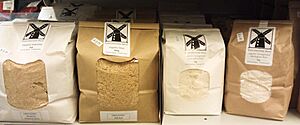Callington Mill facts for kids
Callington Mill is a famous old windmill built in 1837 in Oatlands, Tasmania. It was built by a man named John Vincent. This mill has been carefully fixed up and now works perfectly! It's the only mill of its kind that is still working in the whole Southern Hemisphere (that's the bottom half of the world!). It's also the third oldest windmill in Australia.
Today, Callington Mill is a big tourist attraction in Oatlands. Visitors can go inside and climb up the stairs to see amazing views of Oatlands and the area around it. The mill area includes the windmill itself, a place to store grain (called a granary), a stable for horses, the miller's house, and the house where the mill owner lived.
Contents
The Mill's Early Days
John Vincent, who built the mill, was born in England in 1779. He moved to Tasmania with his family in 1823. He owned a few hotels before deciding to build the Callington Mill around 1836. He was very proud of his new mill and announced its opening in the newspaper in 1837.
The mill was built with the best technology available at the time. It had two pairs of grinding stones and machines to clean the flour. There was also a house, a small shop, a granary, and stables on the property.
John Vincent's oldest son, John Jubilee Vincent, bought the mill from his father around 1840. In 1846, John Jubilee Vincent made a big improvement: he added a steam engine! This meant the mill could work even when there wasn't enough wind. He ran the mill for about ten years.
New Owners and Improvements
In 1853, Thomas Jillett bought Callington Mill. He was a successful sheep farmer from nearby York Plains. He operated the mill for about ten years.
Later, in 1863, Thomas Jillett sold the mill to his nephew, John Bradshaw. John Bradshaw made some important upgrades to the mill. In 1870, he bought a special machine called a silk dressing machine, which helped make the flour even finer. In 1873, he installed a new type of mill stone called a Boddington mill stone. People said this new stone was much better at grinding wheat and could even produce more flour from the same amount of grain! With both wind and steam power, and these new machines, the mill was very important for the farmers in the area.
The Mill Stops Working
Percy Douglas MacLaren bought Callington Mill around 1880. He ran the mill until about 1892. After Percy and his family left Oatlands, the mill stopped working. Not long after, the big sails of the windmill were taken down for safety reasons. You can see a picture of the mill around 1900 after the sails were removed.
Callington Mill Today
Today, Callington Mill is fully restored and working again! It grinds flour from local grain, just like it did over 120 years ago. It's the only working mill of its kind in the Southern Hemisphere, which makes it very special.
Visitors are welcome to come and explore the mill and the surrounding area. You can take guided tours of the mill and climb the tower. The mill is also next to the Oatlands Heritage Highway Visitor Centre.
The mill was even featured on a TV show called Stateline in 2010.
Images for kids


